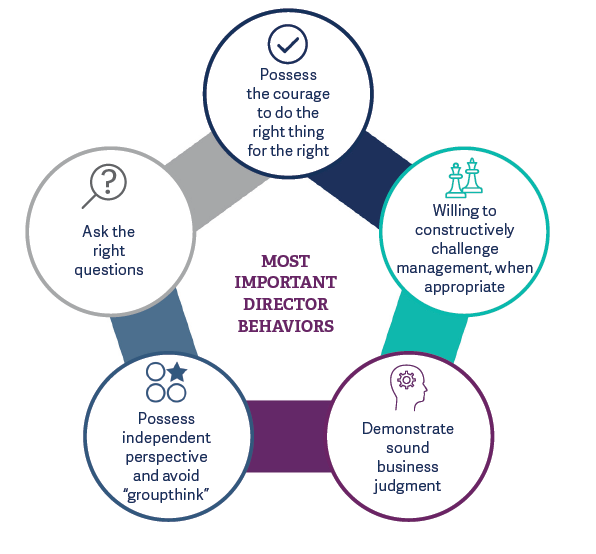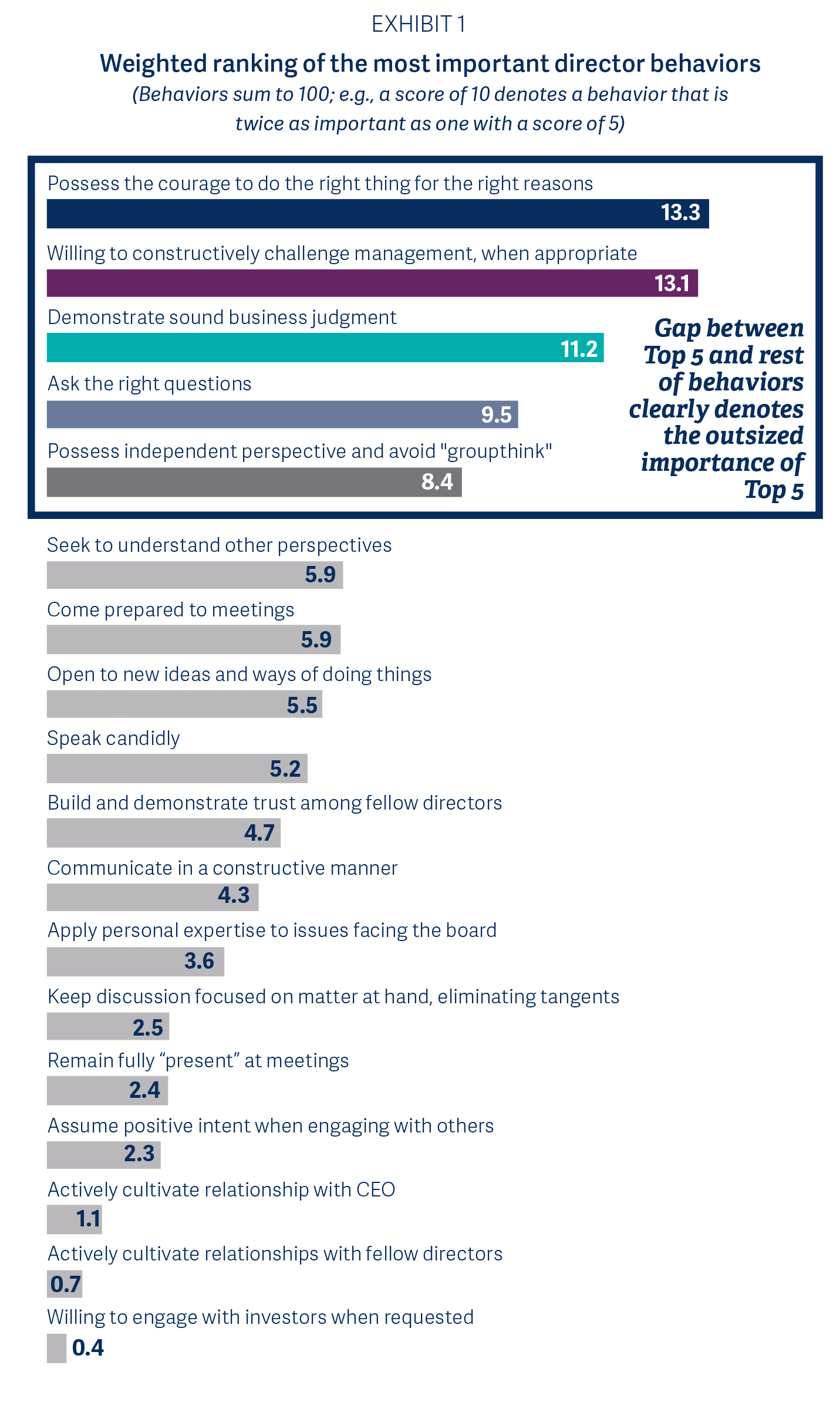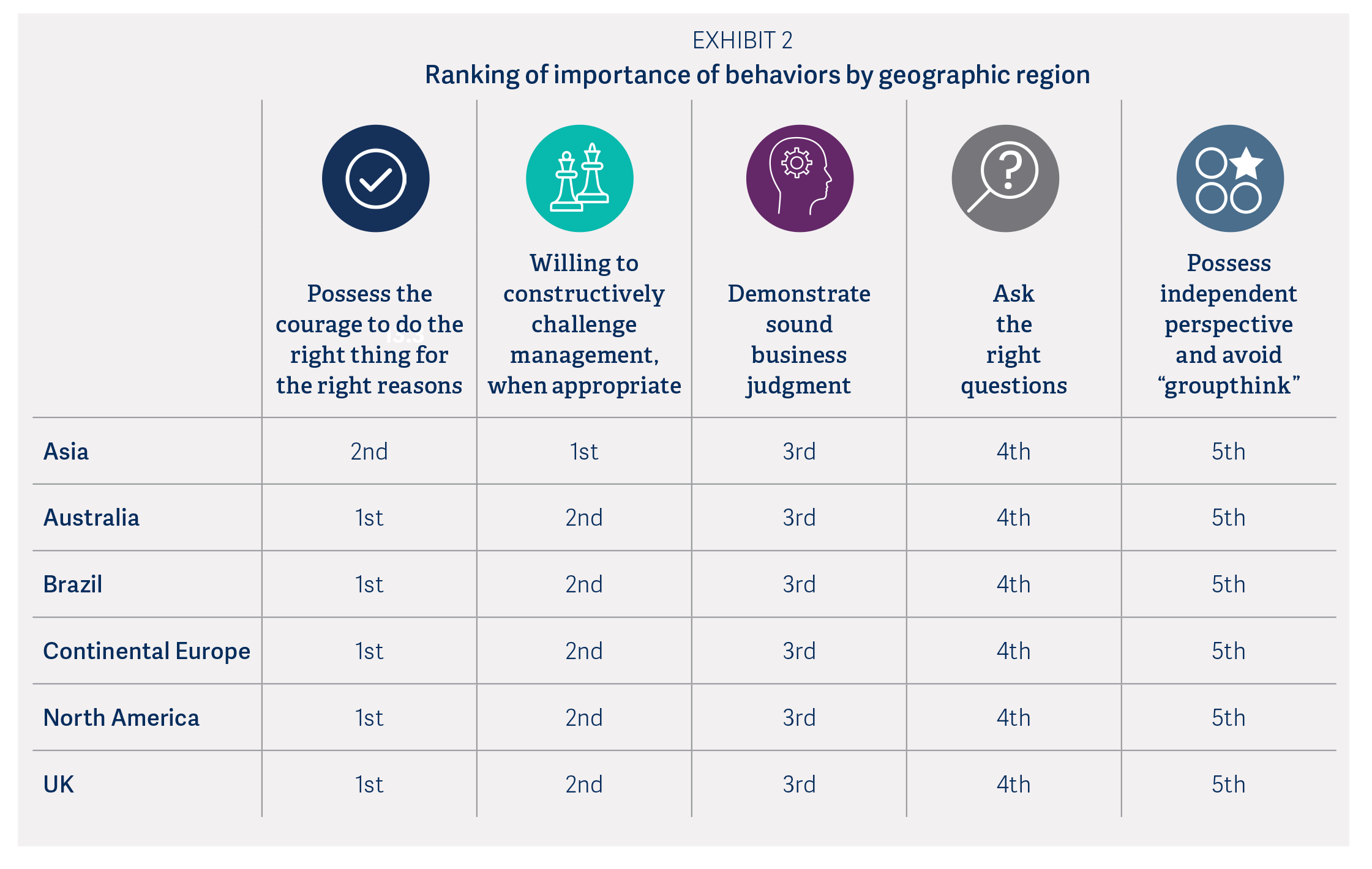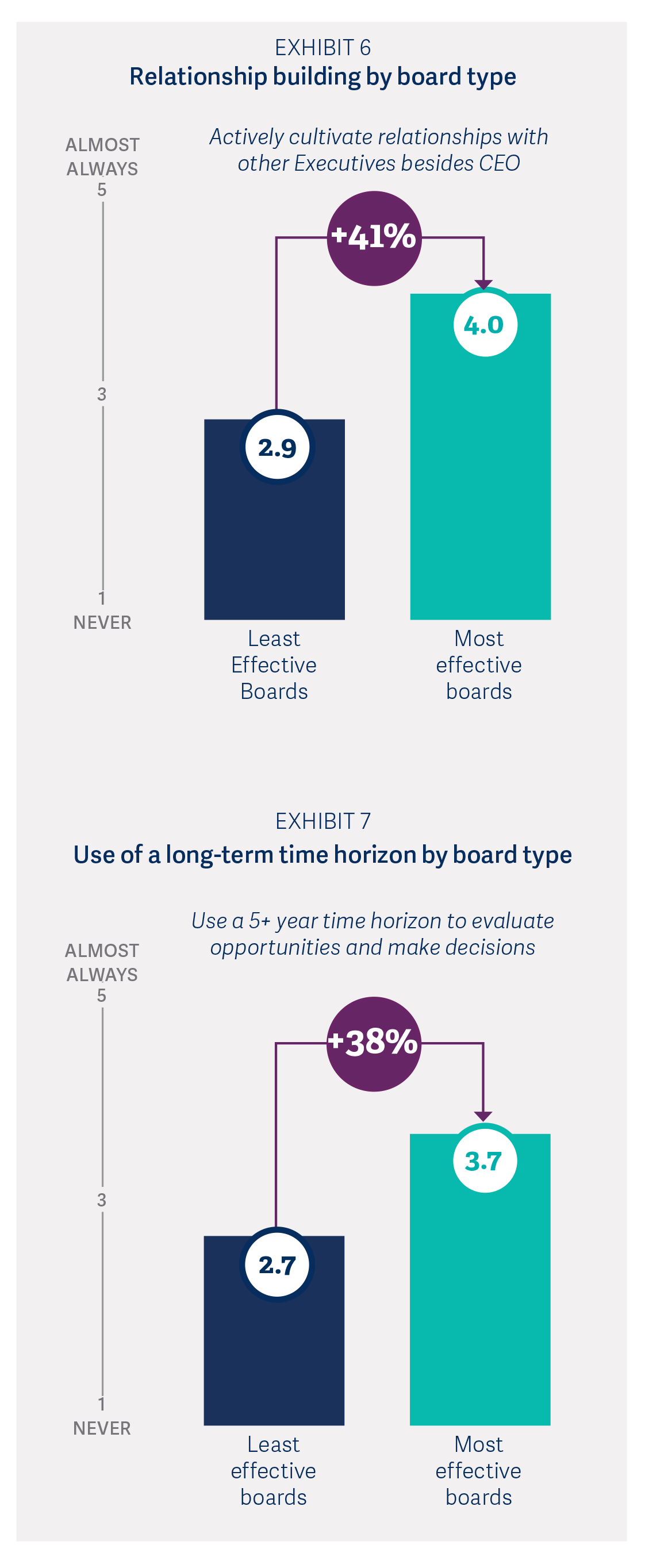Rusty O’Kelley is a member of the CEO and Board Services Practice; and Anthony Goodman is a member of the Board Effectiveness Practice at Russell Reynolds Associates. This post is based on a Russell Reynolds publication.
During the summer of 2016, 369 corporate (supervisory) large public company directors from a dozen countries participated in Russell Reynolds Associates’ Global Board Culture Survey. The goal of the survey was to better understand the director behaviors that create a high-performing board culture and drive board effectiveness.
Directors around the world were surprisingly consistent in the top five behaviors they named as key to a strong culture and an effective board. The survey showed that the attributes that define an effective director transcend cultural and national differences.
Although survey participants agreed on the five key director behaviors, the survey also revealed that only the most effective and well-led boards were able to successfully incorporate the desired director behaviors into how the board actually operates. When we analyzed the actual observed behaviors of the most effective boards we surveyed, we identified three characteristics that drive an effective culture built upon the most important behaviors:
The most effective boards successfully blend the five key director behaviors as the foundation of an effective culture, and are differentiated in the way they operate by the three drivers of effectiveness.
Global consensus on the most important director behaviors
In our survey, we asked directors which behaviors are most important in fostering a board culture that drives effectiveness and company performance. Our research and global experience working with boards show that boards develop their own culture and behavioral norms. For boards to function optimally, the board must have the right mix of relevant expertise and experience, and the board culture should be constructive and engaged.
Given the wide range of corporate governance regimes that exist globally, we expected that the behaviors directors would cite as most important would also vary widely, especially given that corporate boards exist within the context of a national culture. We expected to see some of the common cultural stereotypes play out in our data, with some nationalities favoring more candor and others emphasizing the importance of building trust and respect among directors.
Instead, our study uncovered a surprising degree of consistency in the behaviors that directors believe are most critical for an effective board. Our respondents identified and prioritized the most important director behaviors as depicted in the following chart:
The five most important director behaviors identified topped the rankings for every region we surveyed. Remarkably, they were also ranked in the same order of importance in every region, with the exception of a small variation in Asia. This suggests that the desired qualities of an effective director transcend cultural customs and regional differences.
When we compared the responses of directors serving on a board in their home country with those serving on a board outside their home country, the weighting and ranking of behaviors remained consistent. This suggests that rather than focusing on the traits that make a director suited to a board in a particular country, boards should focus on these five core attributes, which are the most important in any setting.
This global consistency can also be viewed as some evidence of the acceptance and use of the board-centric model of corporate governance that the largest long-term institutional investors (such as BlackRock, State Street, and Vanguard) and pension funds (such as CalPERS, Hermes, and PGGM) have been promoting around the world. This model holds the independence of the board as a central tenet, with heavy emphasis on the board’s ability to challenge management and hold it accountable.
Three drivers of effectiveness to take a board from good to great
While most directors globally agree on which director behaviors are most desired, many boards struggle to incorporate those behaviors into the actual operating norms of the board. In analyzing the data on observed behaviors of boards that were rated extremely effective compared with those that were rated moderately effective or ineffective, we found that the most effective boards were 25%–40% more likely to consistently demonstrate the top five behaviors.
What are these highly effective boards doing differently? Initially, we investigated whether the amount of time spent on board work was a key factor in driving board effectiveness. It is logical that hours invested preparing for board meetings and knowing the business may help make a board more effective. However, our analysis found that the amount of time spent in the boardroom is less important than how that time is spent.
The least effective boards invest 150 hours per year on board-related activity, a full 50 hours (or one-third) less than other boards. However, investing time appears to yield a diminishing return: moderately effective boards spend the same 200 hours per year on board-related activity as the most effective boards. In other words, going from good to great is not about adding hours, but rather about optimizing how those hours are spent.
When we compared the actual observed behaviors of the most effective boards to the rest of the group, three differentiating characteristics emerged. These characteristics contribute to a culture that encourages directors to demonstrate the five key, foundational behaviors that were previously identified. The three differentiating factors of the most effective boards are:
- A chair who is an effective facilitator
- Strong relationships with senior management
- Long-term time horizon for strategic decisions
A Strong Chair Who is an Effective Facilitator
Our survey analysis shows that the effectiveness of the chair was the single biggest differentiator between the most and least effective boards. Specifically, respondents with an effective chair rated their board’s overall effectiveness almost 50% higher than those with an ineffective chair.
Of course, a great board chair should demonstrate the five most important behaviors of a good director. Of these five, courage may be the most underrated and yet most important behavior for a board chair. The chair must possess the courage to make tough decisions in a way that encourages participation and engagement, rather than discourages it.
We then examined the behaviors and leadership qualities of the chair, and our analysis found three chair-specific behaviors that emerged as important in distinguishing the most effective chairs from chairs of average effectiveness: fostering and facilitating high-quality debates, encouraging independence, and actively seeking different points of view. Chairs on the most effective boards are 44%–64% more likely to consistently demonstrate these behaviors. Together, these behaviors depict a chair who encourages lively discussion of the issues from multiple perspectives and seeks to expand the board’s points of view.
The chair is clearly instrumental in establishing the overall culture of the board and encouraging the directors to behave in ways that will increase the board’s effectiveness. By fostering debate, encouraging independence, and actively seeking different points of view, a chair creates a board culture where directors are encouraged to voice their independent perspective, constructively challenge management, and exercise sound judgment.
It is interesting that American, Brazilian, and French directors, who are statistically more likely to serve in a combined CEO/chair role, had a similar perspective on chair behaviors. This indicates that the particular governance structure is less important than the leadership quality and effectiveness of the individual in the role. Additionally, female directors were in general more positive about their board’s effectiveness, but uniformly more critical of their chairs, particularly in areas relating to the chair’s ability to draw out relevant expertise from directors and provide constructive feedback. This may be a leadership and awareness opportunity for some chairs with respect to their style and ability to encourage inclusive discussion and harness the benefits of board diversity.
Building Relationships With Senior Management
The second distinguishing factor of highly effective boards was that their directors go further in getting to know management: these boards are 41% more likely to actively cultivate relationships with the broader executive management team.
These relationships provide the board with more opportunities to learn about the particular strengths and challenges of the various business units and functions, enabling them to ask better questions and demonstrate better judgment in the strategic guidance they provide to management. Moreover, getting to know the depth of the talent bench beneath the CEO significantly improves a board’s effectiveness in CEO and executive succession planning. However, directors must balance building good relationships with management and maintaining their objectivity, independence, and oversight role.
Using A Long-Term Time Horizon To Make Strategic Decisions
We found that the most effective boards are 38% more likely than the least effective boards to use a time horizon of five or more years when evaluating opportunities and making decisions. “Long-termism” has been the focus of an intense debate in the business community worldwide, with institutional investors such as the CPPIB and BlackRock leading the call for boards and management to use longer time horizons when making decisions.
A board that takes a long view is more likely to encourage the most important behaviors from its directors. Taking a longer-term view makes the most of the diversity of perspectives around the table. A long-term time horizon should encourage a robust discussion and a challenge to management based on the different scenarios that can be considered. When short-term gain is not the paramount consideration, directors are more likely to do the right thing for the right reasons, ask better questions, and ultimately exercise more sound judgment.
Indicators of a forward-looking board
The most effective board cultures encourage directors to display the courage needed to do the right thing, constructively challenge management when appropriate, demonstrate sound judgment, ask the right questions, and possess an independent perspective. Our analysis suggests that boards can become highly effective by focusing on three differentiating factors, in addition to promoting the five key behaviors among directors.
We believe that the three differentiating characteristics discussed earlier are forward-looking indicators of effectiveness. When boards focus on these three differentiating drivers of effectiveness, they are also laying the foundation for the company’s future success. Steps taken now to focus a board’s attention on these three drivers will yield dividends for years to come.
What Boards Should Do Next
Based on our experience and our insights from our Global Board Culture Survey, Russell Reynolds Associates suggests that boards and directors do the following:
- Undertake a board effectiveness assessment review against the five behaviors and three factors identified in this paper that drive effectiveness.
- Review the roles, skills, and attributes of board leaders (chair and committee chairs), and pay particular attention to the additional behaviors identified for chairs.
- Ensure that the strategy development process is taking a long-term perspective (five or more years), and that the board adequately reviews and challenges the strategy to hold management accountable.
- Review the CEO succession planning process and identify the board’s role in the development of top talent.
- Review board composition against the emerging strategy and key board behaviors.
Our methodology
The Russell Reynolds Global Board Survey was conducted in June and July 2016. 369 supervisory directors from 12 countries participated in the survey. The companies on whose boards they sit span all industries, and the average company revenue is $16 billion.
We asked participants to use a 1–5 scale to rate how often they observe particular behaviors among their fellow directors on the largest public company board on which they serve. We also asked them to rate the effectiveness of that board, its chair and its culture. From these ratings, boards were classified as least effective (0-6 on a 10 point scale), moderately effective (7-8) or most effective (9-10).
We then asked directors to rate/rank the most and least important behaviors for driving board culture and effectiveness, using a survey methodology that forces participants to make trade-offs between multiple high-value options (with the assumption that integrity was a foundational behavior for any director). This resulted in a weighted score of the importance of each behavior relative to the others.
The 2016 Board Culture Survey had 369 directors from 12 countries participate
- Australia
- Brazil
- Canada
- France
- Germany
- India
- Japan
- Mexico
- Spain
- The Netherlands
- UK
- US
 Print
Print






